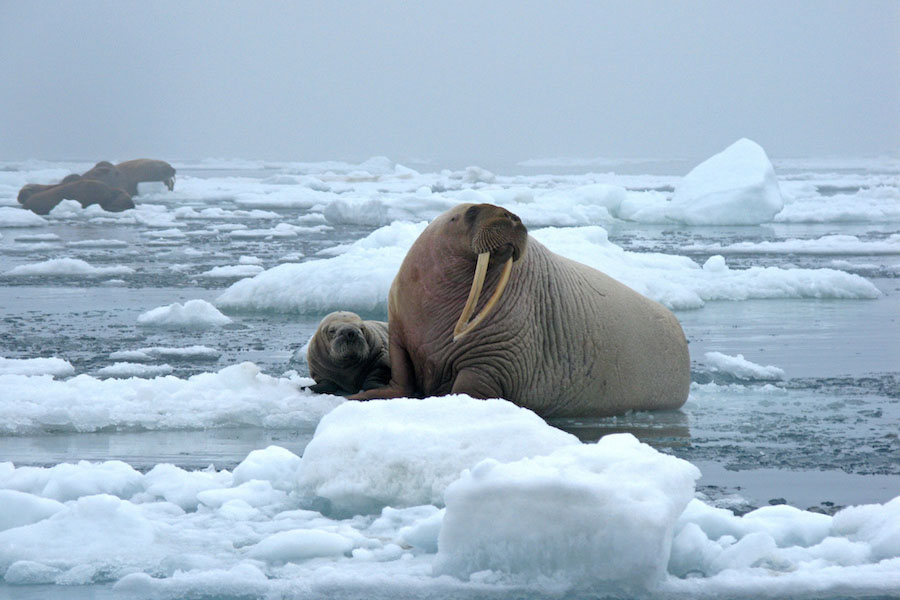
Despite what the DOI says, walruses can’t save themselves
 Last month, Pacific walruses were among the 25 animals to be denied endangered species status by U.S. Fish and Wildlife Service. Although environmental groups have petitioned for the walruses’ protection, the U.S. Department of the Interior defended the decision:
Last month, Pacific walruses were among the 25 animals to be denied endangered species status by U.S. Fish and Wildlife Service. Although environmental groups have petitioned for the walruses’ protection, the U.S. Department of the Interior defended the decision:
“While the Pacific walrus will experience a future reduction in availability of sea ice […], we […] do not have reliable information showing that the magnitude of this change could be sufficient to put the subspecies in danger of extinction now or in the foreseeable future.”
But the DOI previously mentioned the walrus in an undated blog post that discussed animals and climate change.
“Polar bears in many ways have become the symbol of climate change […] The primary cause of their decline: loss of sea ice habitat attributed to Arctic warming,” the DOI said. “Walruses and other Arctic species are facing similar challenges as summer sea ice continues to retreat.”
The department’s inconsistency is troubling — especially since scientists report that summer sea ice will become nonexistent by the 2030s. While the DOI claims that walruses are adapting to ice melt, the animals will lose critical habitat.
More embarrassingly, the DOI insinuated that walruses could figure out climate change problems on their own.
“Pacific walruses are intelligent, adaptable, and able to make the necessary adjustments needed to persist,” said the DOI. “Pacific walruses are not being negatively impacted in a significant way at this time.”
Once walruses determine how to adapt to climate change, maybe they can pass the information along to the rest of us.
Walruses weren’t the only animal associated with climate change to be denied protection. The Florida Keys mole skink, affected by rising sea levels, was among several other animals who remain threatened by climate change impacts and were refused endangered status last month.
The American Pika was also denied endangered species status in 2016 when U.S. Fish and Wildlife claimed that pika were adapting to climate change. Pikas, who thrive in cool mountaintop regions, are threatened by rising temperatures and — studies have shown — could become extinct within the next 100 years.
Climate change deniers pose the greatest threat to animals affected by climate change since offering endangered species status to animals becomes a political decision for policymakers who refuse to accept climate science.
“It’s spectacular cowardice on the part of the Fish and Wildlife Service, who don’t have the courage to do what they are charged with doing, which is to evaluate the scientific evidence, and not kowtow to undue political pressure,” said Stuart Pimm, a scientist specializing in endangered species and biological diversity at Duke University.
Animal extinction is a sad consequence of climate change denial. We’ve improved our lives and made them more convenient with industry and technology, but in the process we’ve destroyed habitats and resources for animals. And the threats we’ve introduced to wildlife are often disregarded or outright denied. How can we continue to look at dwindling species and ignore that we’ve changed their world forever?
The World Wildlife Federation (WWF) discussed the “bleak” outlook for Canadian polar bears in 2009. They hoped “to reach out to the general public using the polar bear as a flagship to clearly demonstrate the importance and negative impacts of climate change” and to “build awareness of climate change impacts on polar bears and other key Arctic wildlife species.”
Eight years have passed since the group made the goal to educate the public about the threat of climate change to wildlife, and we’re no closer to solving our climate change problems — or helping to protect species threatened by climate change. Debating whether climate change affects animals is a diversion we cannot afford.
But we should remain hopeful that people still care enough to help save threatened species by coming together to create solutions that will solve our environmental problems. That’s the message WWF offers the public.
“When it comes to the fight against climate change, there’s reason to be hopeful,” said WWF. “America’s cities, companies, universities and individuals are leading the clean energy revolution — and momentum is on our side. When governments do less, we need to do more. Together we can make a difference and change climate change.”
Written by: Jessica Driver — jmdriver@ucdavis.edu
Disclaimer: The views and opinions expressed by individual columnists belong to the columnists alone and do not necessarily indicate the views and opinions held by The California Aggie.



